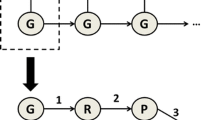Abstract
This paper is about representations for Artificial Intelligence systems. All of the results described in it involve engineering the representation to make AI systems more effective. The main AI techniques studied here are varieties of search: path-finding in graphs, and probablilistic searching via simulated annealing and genetic algorithms. The main results are empirical findings about the granularity of representation in implementations of genetic algorithms. We conclude by proposing a new algorithm, called “Long-Term Evolution,” which is a genetic algorithm running on an evolving problem description. We see this as modelling the evolution of a species from simpler (more coarsely described— fewer genes) types of organisms to more complex ones. The results, which are reported here of our experiments with the algorithm make it seem a promising optimisation technique.
Similar content being viewed by others
References
Amarel, S. (1968). On Representations of Problems of Reasoning About Actions. In Michie (ed.)Machine Intelligence, 3, Edinburgh University Press. 131–171
Banerji, R.B. (1980). Artificial Intelligence: A Theoretical Approach, North-Holland Elsevier Science Publishing.
Davis L. and Steenstrup, M. (1987). Genetic Algorithms and Simulated Annealing: An Overview. In Davis (ed.)Genetic Algorithms and Simulated Annealing, Pitman, 1–11.
de Jong, K. A. (1975). An Analysis of the Behavior of a Class of Genetic Adaptation Systems, PhD Thesis, University of Michigan.
Donald B., Xavier, P., Canny, J., and Reif, J. (1993). Kinodynamic Motion Planning.Journal of the ACM. 40(5), 1048–1066.
Fikes, R. and Nilsson, N.J. (1971). STRIPS: A New Approach to the Application of Theorem Proving to Problem Solving.Artificial Intelligence. 2, 189–208.
Hart, P.E., Nilsson N.J., and Raphael B. (1968) A Formal Basis for the Heuristic Determination of Minimum Cost Paths.IEEE Transactions on Systems Science and Cybernetics. 4(2), 100–107.
Holland, J.H. (1975). Adaptation in Natural and Artificial Systems, The University of Michigan Press.
Holte, R. C., Mkadmi, T., Zimmer R.M., and MacDonald, A.J. (1996). Speeding Up Problem-Solving by Abstraction: A Graph-Oriented Approach.Artificial Intelligence., 85, 321–361.
Holte, R.C., Drummond C., Perez, M.B., Zimmer, R.M., and MacDonald, A.J. (1994). Searching with Abstractions: A Unifying Framework and New High-Performance Algorithm.Proc. of the 10th Canadian Conference on Artificial Intelligence (Artificial Intelligence ’94), Morgan Kaufman Publishers. 263–270.
Kavraki, L. and Latombe J.-C. (1994). Randomized Preprocessing of Configuration Space for Fast Path Planning.Proceedings of the IEEE International Conference on Robotics and Automation.
Kirkpatrick, S., Gelatt, C.D. and Vecchi, M. P. (1983). Optimisation by Simulated Annealing.Science 220. 671–680
Knoblock, C.A. (1990). A Theory of Abstraction for Hierarchical Planning. In Benjamin (ed.)Change of Representation and Inductive Bias, Kluwer. 81–104.
Knoblock, C.A. (1994). Automatically Generating Abstractions for Planning.Artificial Intelligence. 68(2), 243–302.
Korf, R.E. (1980). Towards a Model of Representation Changes.Artificial Intelligence. 14(1), 41–78.
Korf, R.E. (1985). Macro-operators: a weak method for learning,Artificial Intelligence, 26, 35–77.
Metropolis, N, Rosenbluth A., Rosenbluth M, Teller A, Teller E. (1953) “Equation of State Calculations by Fast Computing Machines”,Journal of Chemical Physics 275. Springer-Verlag, 354–372.
Minton S. (1990), Quantitative Results Concerning the Utility of Explanation-based Learning.Artificial Intelligence. 42(2–3), 363–392.
Prieditis, A., and Janakiraman, B. (1993). Generating Effective Admissible Heuristics by Abstraction and Reconstitution.Proc. AAAI ’93. 743–748.
Schraudolph, N.N. and Belew, R.K. (1992). Dynamic Parameter Encoding for Genetic Algorithms.Machine Learning, 9.
Yang, Q. and Tenenberg J.D. (1990), Abtweak: Abstracting a nonlinear, least commitment planner.Proc. AAAI ’90, 204–209.
Zimmer, R. M., MacDonald A.J., and Holte R. C. (1991). Reasoning about Representations.Florida Artificial Intelligence Research Symposium. 201–205.
Zimmer, R. (1990). Category Theory and Representation Engineerin. In Benjamin (ed.)Change of Representation and Inductive Bias, Kluwer.
Author information
Authors and Affiliations
Corresponding author
Rights and permissions
About this article
Cite this article
Zimmer, R., Holte, R. & MacDonald, A. The impact of representation on the efficacy of Artificial intelligence: The case of genetic algorithms. AI & Soc 11, 76–87 (1997). https://doi.org/10.1007/BF02812440
Issue Date:
DOI: https://doi.org/10.1007/BF02812440




